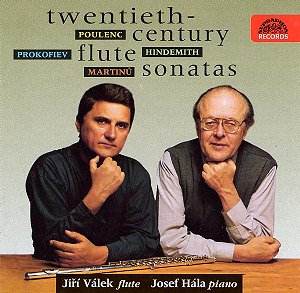|
|
Search MusicWeb Here |
|
 |
||
|
Founder:
Len Mullenger (1942-2025) Editor
in Chief:John Quinn
|
|
|
Search MusicWeb Here |
|
 |
||
|
Founder:
Len Mullenger (1942-2025) Editor
in Chief:John Quinn
|
 |
Francis POULENC (1899-1963) Sonata for Flute and Piano Paul HINDEMITH (1895-1963) Sonata for Flute and Piano Sergey PROKOFIEV (1891-1953) Sonata for Flute and Piano Op 94 Bohuslav MARTINŮ (1890-1959) Sonata for Flute and Piano H306 Josef Hala, piano Recorded April 1978 Dvorak Hall, Rudolfinum, Prague except Martinů, recorded January and February 1989 |
| CD available for post-free online mail-order or you may download individual tracks. For some labels you can download the entire CD with a single click and make HUGE savings. The price you see is the price you pay! The full booklet notes are available on-line. | |
|
NOTE • Click on the button and you can buy the disc or read the booklet details • You can also access each track which you may then sample or down load. • Further Information. |
|
|
Jiri Valek is an adventurous flautist. He has explored the classical heritage, recording Jan and Karl Stamic, Antonin Fils and Frantisek Xaver Richter and here, in recordings dating from 1978 and 1989 he turned to the classics of the twentieth century literature. There is no lack of individual competition in these works but as a conspectus of works written between 1936-57 it has formidable credentials.
Poulenc’s was the last to be written, in 1957, and was the first in his series of sonatas written toward the end of his life. Valek gives full weight – which means a suspension of weight where necessary – to its limpid freshness. Hala is suitably, indeed necessarily, assertive – listen to his chordal support at 2’20 in the first movement. I especially admired the colouration in the slow movement and Valek’s elasticity of phrasing here. The mildly dissonant writing is an attractive feature of the sonata and in the finale where Poulenc reverts to the first movement figure and subjects it to rhythmic mutation Valek and Hala are rightly affectionate.
Hindemith’s sonata likewise was one of a series he wrote, including sonatas for tuba, trumpet, saxophone and trombone. Lyrical, neo-classical it has a slow movement of some real depth and the finale is a witty and firmly moving march, with Valek articulating cleanly and at speed and ends in a small blaze of neo-baroque glory. Prokofiev’s sonata is as well known in its violin guise, arranged by David Oistrakh. Written in the depths of the Second World War and first performed in Moscow in December 1943 it is divergent in spirit and tone from the wartime piano sonatas. There is some graciously witty writing in the Moderato – where I feel Hala is rather more idiomatic than Valek. The pianist is in notably firm form in this sonata, giving full value to his chords in the Scherzo Hala is particularly good in his terraced dynamics the Andante, lyrically releasing Valek with no little skill and sensitivity. The flautist is himself in exuberant mood in the finale, vibrant and sinuous, though maybe the balance here favours the piano overmuch.
There is a perceptible acoustical change in the move from 1978 to 1989 and the final sonata, Martinů’s. No sooner had he finished the Fourth Symphony than he set out (on the following day) to write this work. He was living in Cape Cod at the time and Charlotte, his wife, claimed that the song of an injured bird ran throughout the work. It’s certainly a delicious and lyrical work, with an opening movement that replicates much that we associate with his orchestral techniques. Especially breathtaking is the lyric descent of the Adagio with its line sinking slowly earthward, lower and lower, before it reasserts itself. The rhythmically alive and exciting finale concludes a sonata and a disc of enormous pleasures.
Jonathan Woolf
|
|
ADDITIONAL INFORMATION •
You can sample only 30 seconds (or 15% if that is longer) of a given track. Select from the View tracks list. Each sample will normally start from the beginning but you can drag the slider to any position before pressing play. • PLEASE NOTE: If you are behind a firewall and the sound is prematurely terminated you may need to register Ludwig as a trusted source with your firewall software.
•You will need Quicktime to hear sound samples. Get a free Quicktime download here • If you cannot see the "Sample All Tracks" button you need to download Flash from here.
|
|
|
Return to Index |